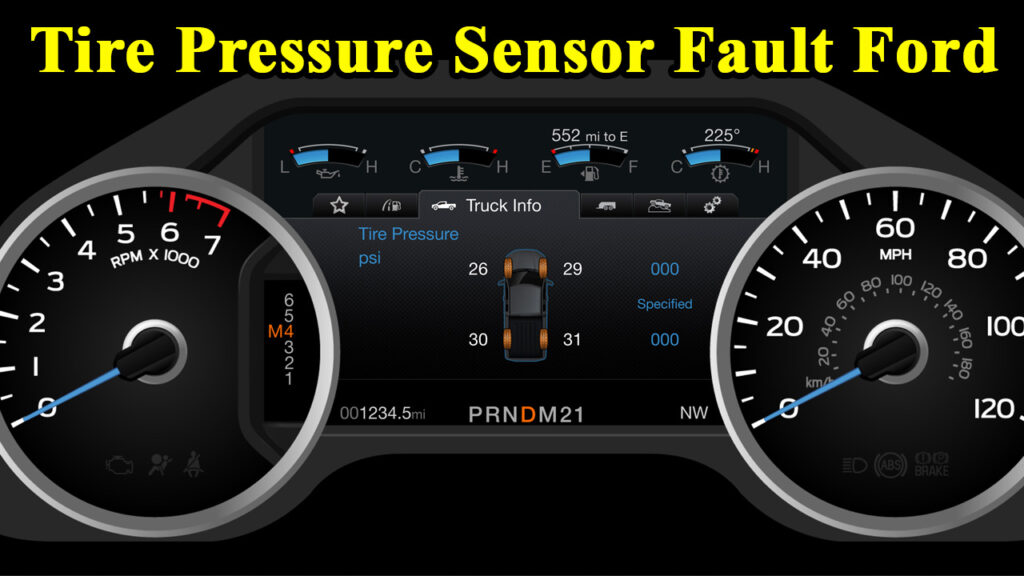Imagine this: you’re cruising down the freeway, enjoying the ride, when suddenly, a little yellow light illuminates on your dashboard – the dreaded tire pressure monitoring system (TPMS) warning. Your heart sinks a little, a familiar scenario for many Ford owners, myself included. I remember once, on a road trip from Chicago to the Upper Peninsula of Michigan, my Ford Explorer’s TPMS light started flashing just as we hit a rough patch of highway near Green Bay. My first thought was a flat, but a quick check revealed all tires looked fine. That’s when I realized it wasn’t a low tire, but a “tire pressure sensor fault” – a different beast entirely.
This seemingly small issue can be a real headache, causing anxiety about your vehicle’s safety and potentially leading to more significant problems if ignored. But what exactly is a tire pressure sensor fault in a Ford, and how do you tackle it? Let’s dive deep into this topic, offering clear explanations, practical solutions, and the kind of insights you’d get from an experienced mechanic, not just a textbook.
Understanding Your Ford’s TPMS System: Your Tire’s Lifeline
Before we talk about faults, let’s understand how your Ford’s TPMS works. Since 2008, all new vehicles sold in the United States have been mandated to include a TPMS. Ford, like most modern manufacturers, utilizes a “direct TPMS” system. This means:
- Individual Sensors: Each of your wheels (and sometimes even your spare!) has a small, battery-powered sensor mounted inside the tire, usually attached to the valve stem.
- Constant Monitoring: These sensors constantly measure the air pressure and temperature within each tire.
- Wireless Communication: They transmit this data wirelessly to your Ford’s Body Control Module (BCM) or a dedicated TPMS control module.
- Dashboard Alert: If a tire’s pressure drops significantly (typically 25% below the recommended cold inflation pressure found on your driver’s side door jamb), or if a sensor malfunctions, your dashboard TPMS light illuminates. A solid light usually indicates low pressure, while a flashing light often signals a sensor fault or battery issue.
Why is this crucial? Beyond the obvious safety aspect of preventing blowouts and loss of control, a properly functioning TPMS contributes to:
- Fuel Efficiency: Underinflated tires increase rolling resistance, making your engine work harder and consuming more fuel.
- Tire Longevity: Correct tire pressure ensures even tire wear, extending their lifespan and saving you money on replacements.
- Optimal Handling: Properly inflated tires provide the best grip and handling characteristics for your vehicle.
The Culprits: Common Causes of Ford Tire Pressure Sensor Faults
When that “Tire Pressure Sensor Fault” message pops up on your Ford’s dash, it’s usually one of a few common culprits. From my years of working on vehicles, these are the usual suspects:
-
The Silent Killer: Dead Sensor Battery This is, by far, the most frequent cause. TPMS sensors are powered by tiny, non-rechargeable lithium-ion batteries sealed within the sensor unit. These batteries typically last anywhere from 5 to 10 years, with an average lifespan of around 7 years. Once the battery dies, the sensor stops transmitting, and your Ford flags it as a fault. Think of it like a remote control with dead batteries – it’s still a good remote, but it just won’t work.
-
Physical Trauma: Sensor Damage Life on the road can be tough. Potholes, curb strikes, and even careless handling during tire mounting or repair can damage these delicate sensors. I’ve seen countless instances where a tire technician, unaware or rushed, accidentally nicks or breaks a sensor while dismounting a tire. In regions with rough roads, like parts of rural Ohio where I’ve spent time, sensor damage from impacts is surprisingly common.
Beyond the Tread: A Deep Dive into the Enduring Legacy of L&M Tire
-
The Corrosive Threat: Rust and Environmental Wear Especially in climates like the Northeast or Midwest, where road salt is heavily used in winter, corrosion can be a significant issue. Moisture and salt can seep into the sensor’s housing or around the valve stem, causing electrical contacts to corrode and interrupting the signal. This is a sneaky one because the sensor might look fine from the outside.
-
Internal Breakdown: Sensor Malfunction/Failure While less common than a dead battery, sometimes the internal components of a TPMS sensor simply fail. This could be due to manufacturing defects (rare with OEM, more possible with cheap aftermarket parts), extreme temperature fluctuations, or just plain old wear and tear.
-
The Brain of the Operation: TPMS Module Issues Your Ford’s TPMS sensors communicate with a central control module (often integrated into the BCM). If this module malfunctions, it can prevent proper communication with the sensors, leading to a system-wide fault, even if the individual sensors are fine. This is less common and usually requires more in-depth diagnostic work.
-
The Quick Fix that Causes Long-Term Pain: Tire Sealant Use Many emergency tire repair kits come with a sealant that you inject into the tire. While helpful in a pinch, these gooey sealants can coat and clog the pressure port of your TPMS sensor, preventing it from accurately reading pressure and potentially damaging its internal components. Ford’s own owner’s manuals often explicitly warn against using tire sealants due to potential TPMS damage.
-
The Reset Ritual: Incorrect Tire Rotation or Replacement When you rotate your tires or install new ones, your Ford’s TPMS system often needs to “relearn” the new sensor positions. If this relearn procedure isn’t performed correctly, or at all, your vehicle’s computer might still be looking for sensors in their old locations, flagging a fault. Modern Fords are often smarter and can auto-relearn, but it’s not foolproof.
-
Software Glitches: ECU/BMS Hiccups Sometimes, the fault isn’t mechanical at all. A temporary glitch in your vehicle’s engine control unit (ECU) or BCM can trigger a false TPMS fault. This is often resolved with a simple system reset.
Cracking the Code: Diagnosing a Ford TPMS Fault
When your Ford throws a TPMS fault, don’t panic. Here’s a systematic approach to diagnosing the issue:
-
Check Your Tire Pressure – The Obvious First Step! I know, it sounds basic, but trust me, many “sensor faults” are simply very low tires. Use a reliable tire pressure gauge and manually check all four tires, and your spare if applicable. Inflate them to the recommended cold inflation pressure listed on your driver’s door jamb. If the light goes off after driving a few miles, problem solved!
-
Observe the Dashboard Light:
- Solid TPMS Light: This usually means one or more tires are significantly underinflated. Check pressures immediately.
- Flashing TPMS Light (then solid): This is the classic indicator of a TPMS system malfunction, most commonly a dead sensor battery or a damaged sensor.
-
Invest in an OBD-II Scanner (with TPMS Functionality): This is where you start to get serious. A basic OBD-II scanner can read general engine codes, but for TPMS issues, you need one that can communicate with your Ford’s TPMS module. These scanners can often:
- Read specific TPMS diagnostic trouble codes (DTCs), which typically start with “C” (e.g., C1234).
- Identify which specific sensor is reporting the fault.
- Display the pressure readings from each individual sensor in real-time.
- Initiate the TPMS relearn/reprogram procedure. Many affordable handheld TPMS scan tools are available online for $50-$150, a worthwhile investment for any Ford owner.
-
Professional Diagnosis: When to Call the Experts If your scanner points to a specific sensor, or if you’re uncomfortable with the process, it’s time to visit a professional. A Ford dealership or a trusted independent mechanic shop will have advanced diagnostic tools that can pinpoint the exact problem quickly and accurately. They can also perform necessary programming.
The Fix-It Guide: Resolving Your Ford TPMS Fault
Once you’ve diagnosed the fault, here’s how to go about fixing it:
-
The Simple Reset: A Quick Fix for Glitches Sometimes, a TPMS fault is just a temporary glitch. For many Ford models, a simple reset procedure can clear the light. While specific steps vary by model and year, a common procedure involves:
- Turn the ignition to the “OFF” position.
- Press and release the brake pedal.
- Cycle the ignition from “OFF” to “RUN” (engine off) three times, ending in the “RUN” position.
- Press and release the brake pedal again.
- Cycle the ignition from “OFF” to “RUN” three times, ending in the “RUN” position.
- The horn may chirp once, and the TPMS light should flash, indicating it’s in relearn mode.
- Then, you might need to drive the vehicle for a few minutes (often above 20 MPH) for the sensors to transmit new data and the system to reset.
Mastering Winter with Your BMW i3: An In-Depth Look at Blizzak 175/60/19 Tires
-
Replacing a Faulty TPMS Sensor: The Most Common Repair If the diagnosis points to a bad sensor (most often due to a dead battery), replacement is necessary.
- DIY vs. Professional: Replacing a TPMS sensor involves dismounting the tire from the wheel, replacing the sensor, and then remounting and balancing the tire. This requires specialized tire changing equipment. Unless you have experience and the right tools, this is best left to a professional. Trying to force it can damage your wheel or the new sensor.
- OEM vs. Aftermarket Sensors:
- OEM (Original Equipment Manufacturer) Sensors: These are identical to the sensors that came with your Ford from the factory. They are typically more expensive, ranging from $40 to $80 per sensor, but offer guaranteed compatibility and often greater longevity. My personal experience leans towards OEM when possible – they just seem to integrate seamlessly and avoid the headaches some aftermarket sensors can cause.
- Aftermarket Sensors: These are cheaper, often costing $20 to $50 per sensor. While many reputable aftermarket brands exist, some generic ones can be problematic, leading to compatibility issues or shorter lifespans. If choosing aftermarket, opt for well-known brands like Schrader or Autel, which are often suppliers to OEMs anyway.
- Programming New Sensors (Relearn Procedure): After replacing a sensor, it must be programmed or “relearned” to your Ford’s TPMS module. This typically involves using a TPMS activation tool (often called a “trigger tool” or “relearn tool,” available for $20-$50 online) to activate each sensor in a specific order (usually left front, right front, right rear, left rear), often combined with a sequence of ignition cycles and brake pedal presses as described in your owner’s manual. Your mechanic will perform this step as part of the replacement.
-
Addressing Other Issues:
- Module Replacement: If the TPMS control module is confirmed to be faulty, its replacement is a more complex and costly repair, often running into several hundred dollars for parts and labor, as it might involve specialized programming by a dealership.
- Wiring Repair: Damaged wiring leading to the TPMS module or individual wheel speed sensors (which can sometimes play a role in indirect TPMS systems, though Ford largely uses direct) can be repaired by an auto electrician.
Cost of Repair (Estimated Values – Labor Extra):
- Single TPMS Sensor: $20 – $80 (part only)
- Full Set of 4 TPMS Sensors: $80 – $320 (parts only)
- Labor to Replace One Sensor: $30 – $70 (per tire, includes mounting, balancing, and programming)
- Total for One Sensor Replacement: Roughly $50 – $150
- TPMS Module Replacement: $200 – $600+ (parts and labor)
Keeping the Light Off: Prevention and Maintenance
An ounce of prevention is worth a pound of cure, especially with TPMS sensors.
- Regular Manual Pressure Checks: Don’t rely solely on your TPMS light! Check your tire pressure manually at least once a month, and before long trips, when the tires are cold.
- Professional Tire Service: When getting new tires or rotations, ensure the shop is experienced with TPMS systems. Ask them to inspect your sensors and be prepared for potential replacement if your sensors are nearing their battery life expectancy. I always recommend discussing TPMS sensor health with the tire shop when you’re getting new rubber – it’s often the most cost-effective time to replace them.
- Avoid Tire Sealants: As mentioned, these can damage sensors. Carry a tire plug kit or a small air compressor instead for minor punctures.
- Consider Sensor Replacement with New Tires: If your sensors are 7+ years old and you’re buying new tires, it’s a smart move to replace all the sensors at the same time. You’re already paying for tire mounting and balancing, so the added labor for sensor replacement is minimal compared to coming back later for individual sensor failures.
- Winter Driving Awareness: Tire pressure drops in cold weather (roughly 1 PSI for every 10-degree Fahrenheit drop). Don’t be surprised if your TPMS light comes on during the first cold snap of the season. It might just need a pressure top-up.
Real-World Scenarios: Examples and Case Studies
Case Study 1: The Midwestern Winter Warrior My friend, who drives an older Ford F-150 in Wisconsin, constantly battled his TPMS light during winter. We’d check the pressure, fill the tires, and the light would eventually return. Upon inspection at a local tire shop, they found significant corrosion around the valve stems on three of his sensors due to years of salty roads. Replacing those corroded sensors with new, corrosion-resistant OEM units finally solved his persistent issue, proving that environmental factors are a big player.
Case Study 2: The “Emergency Fix” Gone Wrong A client with a Ford Fusion had a slow leak. Instead of taking it to a shop, they used a can of tire sealant from a roadside emergency kit. The leak stopped, but a few days later, the TPMS light came on with a “sensor fault” message. We found the sealant had completely coated the internal pressure port of the sensor, rendering it useless. A new sensor and a thorough tire cleaning were required. This highlights the importance of professional tire repair over temporary sealant solutions.
Example: The Simple Reset Victory After a recent tire rotation on my Ford Edge, the “Tire Pressure Sensor Fault” message appeared. I knew the tires were properly inflated. Instead of rushing to a mechanic, I followed the manual TPMS reset procedure (cycling the ignition and pressing the brake). After a short drive, the system relearned the sensor positions, and the light went off. Sometimes, it truly is that simple!
Value, Originality, and a Personal Touch
Understanding your Ford’s TPMS isn’t just about fixing a light; it’s about valuing your safety, preserving your investment, and maintaining your vehicle’s optimal performance. The information presented here isn’t just generic advice; it’s born from countless hours under the hood, hands-on experience, and the shared frustrations and triumphs of myself and other Ford owners. Every flicker of that TPMS light tells a story, and knowing how to read it can save you time, money, and stress.
Conclusion: Be Proactive, Stay Safe
The tire pressure monitoring system in your Ford is a vital safety feature, not just a nuisance light on your dash. A “tire pressure sensor fault” might seem intimidating, but by understanding its causes, knowing how to diagnose it, and being aware of the repair options, you can approach the problem with confidence. Whether it’s a simple reset, a battery replacement, or addressing corrosion, being proactive with your tire and TPMS maintenance will ensure your Ford remains safe, efficient, and reliable for years to come. Don’t let that silent alarm turn into a roadside emergency!
Frequently Asked Questions (FAQ)
Q1: How long do Ford TPMS sensors typically last? A1: Ford TPMS sensors, like most direct TPMS sensors, have a lifespan of approximately 5 to 10 years, with an average of 7 years. Their internal batteries are non-replaceable, so when the battery dies, the entire sensor needs to be replaced.
Q2: Can I drive with a TPMS fault light on in my Ford? A2: While you can drive with a TPMS fault light on, it’s not recommended. A flashing TPMS light indicates a system malfunction, meaning you won’t be alerted if your tire pressure actually drops. This compromises a crucial safety feature. Always check your tire pressure manually if the light is on, and address the fault as soon as possible.
Q3: Do I need to reprogram TPMS sensors after a tire rotation on my Ford? A3: For many newer Ford models, the system can automatically relearn sensor positions after a rotation simply by driving the vehicle. However, some models, or if the auto-relearn doesn’t work, may require a manual relearn procedure using an activation tool or a specific sequence of steps (refer to your Ford owner’s manual).
Q4: Why is my TPMS light still on after I’ve fixed the tire pressure? A4: If the light remains on after you’ve inflated your tires to the correct pressure, it’s likely one of two things: * The system needs time to register the new pressure. Drive for a few miles (often above 20 MPH) to allow the sensors to transmit. * There’s an underlying sensor fault (e.g., dead battery, damage, or corrosion) that needs to be diagnosed and addressed.
Q5: What’s the difference between OEM and aftermarket TPMS sensors for Ford, and which should I choose? A5: OEM (Original Equipment Manufacturer) sensors are made by the same company that supplied Ford for your vehicle, ensuring perfect compatibility. Aftermarket sensors are made by third-party companies. While aftermarket options are generally cheaper ($20-$50 vs. $40-$80 for OEM), some can be unreliable. For peace of mind and guaranteed compatibility, OEM sensors are often preferred, but reputable aftermarket brands like Schrader or Autel are generally good choices if you’re looking to save some money.


